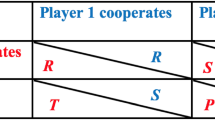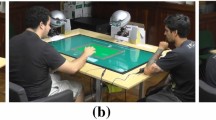Abstract
In everyday life, we often observe and learn from interactions between other individuals—so-called third-party encounters. As robots are poised to become an increasingly familiar presence in our daily lives, third-party encounters between other people and robots might offer a valuable approach to influence people’s behaviors and attitudes towards robots. Here, we conducted an online experiment where participants (n = 48) watched videos of human—robot dyads interacting in a cooperative or competitive manner. Following this observation, we measured participants’ behavior and attitudes towards the human and robotic agents. First, participants played a game with the agents to measure whether their behavior was affected by their observed encounters. Second, participants’ attitudes toward the agents were measured before and after the game. We found that the third-party encounters influenced behavior during the game but not attitudes towards the observed agents. Participants showed more effort towards robots than towards humans, especially when the human and robot agents were framed as competitive in the observation phase. Our study suggests that people’s behaviors towards robots can be shaped by the mere observation of third-party encounters between robots and other people.
R. H. Timmerman and T.-Y. Hsieh—Co-first authors.
A. Henschel, R. Hortensius and E.S. Cross—Co-senior authors.
Access this chapter
Tax calculation will be finalised at checkout
Purchases are for personal use only
Similar content being viewed by others
References
Johnson, J.D., Ashburn-Nardo, L.: Soc. Psychol. Personal. Sci. 5(3), 369–376 (2014). https://doi.org/10.1177/1948550613499938
Mazziotta, A., et al.: Group Process. Intergroup Relat. 14(2), 255–274 (2011). https://doi.org/10.1177/1368430210390533
Quadflieg, S., Penton-Voak, I.S.: Curr. Dir. Psychol. Sci. 26(4), 383–389 (2017). https://doi.org/10.1177/0963721417694353
Quadflieg, S., Westmoreland, K.: Making sense of other people’s encounters: towards an integrative model of relational impression formation. J. Nonverbal Behav. 43(2), 233–256 (2019). https://doi.org/10.1007/s10919-019-00295-1
Shapiro, J.R., et al.: J. Exp. Soc. Psychol. 47(1), 221–227 (2011). https://doi.org/10.1016/j.jesp.2010.10.006
Vezzali, L., et al.: Group Process. Intergroup Relat. 22(7), 1059–1076 (2019). https://doi.org/10.1177/1368430218809885
West, K., Turner, R.: J. Exp. Soc. Psychol. 50, 57–64 (2014). https://doi.org/10.1016/j.jesp.2013.06.009
Willard, G., et al.: Organ. Behav. Hum. Decis. Process. 128, 96–107 (2015). https://doi.org/10.1016/j.obhdp.2015.04.002
Winkler, P., et al.: Short video interventions to reduce mental health stigma: a multi-centre randomised controlled trial in nursing high schools. Soc. Psychiatry Psychiatr. Epidemiol. 52(12), 1549–1557 (2017). https://doi.org/10.1007/s00127-017-1449-y
Eller, A., et al.: Int. J. Intercult. Relat. 36(5), 637–646 (2012). https://doi.org/10.1016/j.ijintrel.2012.03.005
Lemmer, G., Wagner, U.: EJSP. 45(2), 152–168 (2015). https://doi.org/10.1002/ejsp.2079
Skinner, A.L., et al.: Psychol. Sci. 28(2), 216–224 (2017). https://doi.org/10.1177/0956797616678930
Broadbent, E.: Annu. Rev. Psychol. 68(1), 627–652 (2017). https://doi.org/10.1146/annurev-psych-010416-043958
Wullenkord, R., Eyssel, F.: 23rd IEEE International Symposium on Robot and Human Interactive Communication (2014). https://doi.org/10.1109/ROMAN.2014.6926300
Correia, F., et al.: 14th ACM/IEEE International Conference on HRI, pp. 143–151 (2019). https://doi.org/10.1109/HRI.2019.8673299
Fraune, M.R., et al.: Comput. Hum. Behav. 105, e9414 (2020). https://doi.org/10.1016/j.chb.2019.106220
Nomura, T., et al.: IEEE Trans. Robot. 24(2), 442–451 (2008). https://doi.org/10.1109/TRO.2007.914004
Walbrin, J., et al.: Neuropsychologia 112, 31–39 (2018). https://doi.org/10.1016/j.neuropsychologia.2018.02.023
Peirce, J., et al.: PsychoPy2: experiments in behavior made easy. Behav. Res. Methods 51(1), 195–203 (2019). https://doi.org/10.3758/s13428-018-01193-y
DaVinci Resolve Engineering Team, Blackmagic Design (2019)
R Core Team: Foundation for Statistical Computing (2020)
Bates, D., et al.: ArXiv14065823 Stat, June 2014. http://arxiv.org/abs/1406.5823. Accessed 25 Jan 2021
Barr, D.J., et al.: J. Mem. Lang. 68(3), 255–278 (2013). https://doi.org/10.1016/j.jml.2012.11.001
Christensen, R.H.B.: 2019. https://CRAN.R-project.org/package=ordinal. Accessed 25 Jan 2021
Lenth, R.V., et al. https://CRAN.R-project.org/package=emmeans. Accessed 15 Feb 2021
Sandoval, E.B., Brandstetter, J., Obaid, M., Bartneck, C.: Reciprocity in human-robot interaction: a quantitative approach through the prisoner’s dilemma and the ultimatum game. Int. J. Soc. Robot. 8(2), 303–317 (2015). https://doi.org/10.1007/s12369-015-0323-x
Xu, J., Howard, A.: 2018 27th IEEE International Symposium on Robot and Human Interactive Communication (RO-MAN), pp. 435–441, August 2018. https://doi.org/10.1109/ROMAN.2018.8525669.
Paetzel, M., et al: Proceedings of the 2020 ACM/IEEE International Conference on HRI, New York, NY, USA, pp. 73–82, March 2020. https://doi.org/10.1145/3319502.3374786.
Huisman, G., Kolkmeier, J., Heylen, D.: With us or against us: simulated social touch by virtual agents in a cooperative or competitive setting. In: Bickmore, T., Marsella, S., Sidner, C. (eds.) IVA 2014. LNCS (LNAI), vol. 8637, pp. 204–213. Springer, Cham (2014). https://doi.org/10.1007/978-3-319-09767-1_25
Walters, M.L., et al.: 2009. http://uhra.herts.ac.uk/handle/2299/9642. Accessed 20 Feb 2021
Scheunemann, M.M., et al.: 2020 29th IEEE International Conference on Robot and Human Interactive Communication, pp. 1340–1347, August 2020. https://doi.org/10.1109/RO-MAN47096.2020.9223478
Mutlu, B., et al.: Proceedings of the 1st ACM SIGCHI/SIGART Conference on HRI, New York, NY, USA, pp. 351–352. March 2006. https://doi.org/10.1145/1121241.1121311
Hsieh, T.-Y., et al.: PsyArXiv, 08 July 2020. https://doi.org/10.31234/osf.io/q6pv7.
Hortensius,R., Cross, E.S.: Ann. N. Y. Acad. Sci. 1426(1), August 2018. Art. no. 1. https://doi.org/10.1111/nyas.13727
Bridges, D., et al.: PeerJ 8, e9414 (2020). https://doi.org/10.7717/peerj.9414
de Leeuw, J.R., Motz, B.A.: Psychophysics in a Web browser? Comparing response times collected with JavaScript and psychophysics toolbox in a visual search task. Behav. Res. Methods 48(1), 1–12 (2015). https://doi.org/10.3758/s13428-015-0567-2
Miller, R., Schmidt, K., Kirschbaum, C., Enge, S.: Comparability, stability, and reliability of internet-based mental chronometry in domestic and laboratory settings. Behav. Res. Methods 50(4), 1345–1358 (2018). https://doi.org/10.3758/s13428-018-1036-5
Wainer, J., et al.: ROMAN 2006 - The 15th IEEE International Symposium on Robot & Human Interactive Communication, pp. 117–122, September 2006. https://doi.org/10.1109/ROMAN.2006.314404
Cross, E.S., Ramsey, R.: Trends Cog Sci. 25(3), 200–2012 (2021). https://doi.org/10.1016/j.tics.2020.11.009
Henschel, A., et al.: Trends Neurosci. 43(6), 373–384 (2020). https://doi.org/10.1016/j.tins.2020.03.013
Funding
Research supported by funding from the European Research Council (ERC) under the European Union's Horizon 2020 research and innovation program (Grant agreement number 677270 to E.S.C.), the Leverhulme Trust (PLP-2018–152 to E.S.C), and the BIAL Foundation (to R.H.).
Author information
Authors and Affiliations
Corresponding author
Editor information
Editors and Affiliations
Rights and permissions
Copyright information
© 2021 Springer Nature Switzerland AG
About this paper
Cite this paper
Timmerman, R.H., Hsieh, TY., Henschel, A., Hortensius, R., Cross, E.S. (2021). Individuals Expend More Effort to Compete Against Robots Than Humans After Observing Competitive Human–Robot Interactions. In: Li, H., et al. Social Robotics. ICSR 2021. Lecture Notes in Computer Science(), vol 13086. Springer, Cham. https://doi.org/10.1007/978-3-030-90525-5_60
Download citation
DOI: https://doi.org/10.1007/978-3-030-90525-5_60
Published:
Publisher Name: Springer, Cham
Print ISBN: 978-3-030-90524-8
Online ISBN: 978-3-030-90525-5
eBook Packages: Computer ScienceComputer Science (R0)




